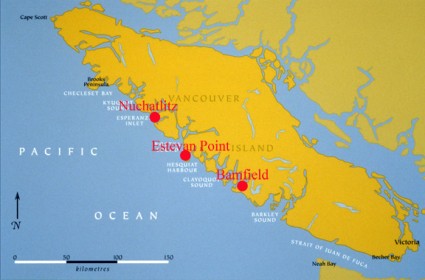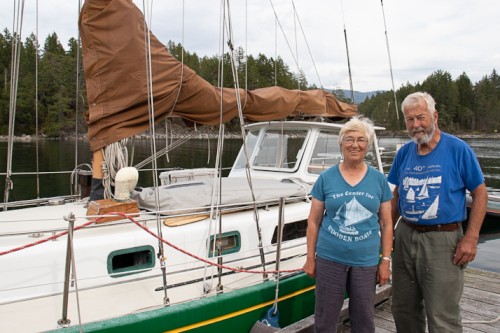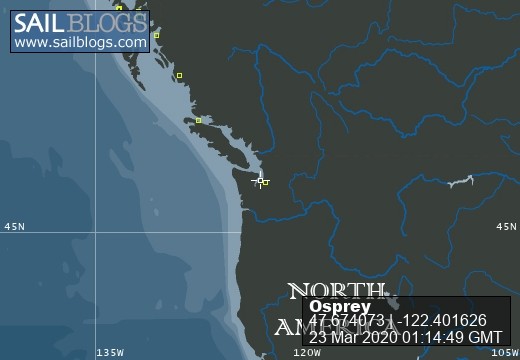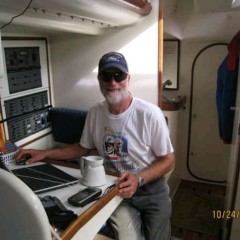Voyages North
23 July 2023
21 August 2021
11 July 2021 | Posted in Seattle
16 May 2021
07 January 2021
10 April 2020 | Posted in Seattle
31 August 2019 | Posted at Port McNeill
31 August 2019
30 August 2019
30 August 2019 | Posted at Port MCNeill
13 August 2019 | Posted at Prince Rupert
13 August 2019 | Posted at Prince Rupert
03 August 2019 | Posted at Ketchikan
02 August 2019 | Posted at Metlakatla
02 August 2019 | posted in Metlakatla AK
22 July 2019 | Posted at Klawock/Craig
22 July 2019 | Posted at Klawock/Craig
09 July 2019 | Posted at Juneau
09 July 2019 | Posted at Juneau
27 June 2019
West Coast of Vancouver Island: Preparation for SE Alaska
12 December 2011

Map: Vancouver Island showing three locations depicted in this blog
"I'd love to do what you did, sail to Alaska, but I'm just too scared."
A fellow sailor said this to me at a birthday party a couple of weeks ago while we were standing in front of the hors d'oeuvres table.
"What is it that scares you?" I asked the woman.
She paused for a minute before answering, "We wouldn't know what to do out there, how to sail in unfamiliar waters. Maybe if there were a class we could take, it would help." (She sails with her husband).
There are classes, although they're not taught every year and it may be difficult to track them down. One seminar given in the past has been organized by Fine Edge Nautical and Recreational Publishing in Anacortes. (Call (360) 299-8500 to find out if one has been scheduled.) A version of it is also taught at the Seattle Boat Show University. The principal instructor, Linda Lewis, gives blow-by-blow descriptions of the major passages on the route to Alaska. Linda also does private instruction and can help you plan your trip.
I told the woman about the seminar but when she turned away after hearing about it, I sensed my answer hadn't been enough.
Thinking about our conversation days later, I wondered, what I could have said to encourage her. Then I went on to ponder the fact, with some amazement, that I hadn't been afraid at all when we'd planned our first trip to Alaska. Sure I'd been scared on some of the passages, when the wind was strong or seas were up. But I wasn't really nervous about the trip as a whole.
Why hadn't I been afraid? The 18 trips Steve and I took to the west coast of Vancouver Island over a period of 25 years before we sailed to Alaska gave us practice facing many of the same kinds of conditions we found in Alaska.
Lots of people sail to the west coast of Vancouver Island as a shake-down trip for offshore cruising. It makes a great shake-down for Alaska too. One of the keys to tackling your fears is to break them into little bits. Since you can get to the west coast of Vancouver Island and back in just a few weeks, the idea of going there is not as overwhelming as sailing to Alaska. Overcoming fear requires confidence in your boat, yourself and your partner. You can gain all three sailing the west coast of Vancouver Island.
Here are some of the conditions we encountered on the west coast of Vancouver Island that prepared us for SE Alaska: All of the incidents below are described in more detail in my book Voyages to Windward: Sailing Adventures on Vancouver Island's West Coast.
1. Rough seas and strong winds.

Sailing downwind around Estevan Point (1984).
Although the west coast of Vancouver Island is blessed with a series of sounds and inlets that provide sheltered anchorages, you have to sail in the ocean to get from one sound or inlet to another.
The day I took this picture was one of the scariest days I've ever had when sailing. We were sailing from Esperanza Inlet to Clayoquot Sound in northwest gales. Although we had a chart for every inlet, we didn't have one that showed the whole stretch of coast between Esperanza Inlet and Clayoquot Sound. As a result we got too close to Estevan Point and broached in heavy seas. But the boat righted itself, we pumped it out as best we could and made it through. An experience like that teaches you what your boat can do -- and makes you determined to avoid a similar situation. Now we always double check our list of chart and stay far offshore of any shallows. And we would never sail in unfamiliar waters without paper charts because we value the overview they give.
If you can sail in conditions like those we encountered off Estevan that day, you can certainly round Cape Caution and cross the Dixon Entrance, the two open-water passages enroute to Southeast Alaska.
2. Navigating among rocks.

Entrance to Nuchatlitz
Although the description of this seldom-visited Native fishing village in our guide book intrigued me, our first trip through the channel terrified me. There were so many rocks and Steve insisted on sailing in instead of motoring. But we found our way through the rocks without incident-- and then we learned there was an easier route!
By entering under sail where most where most boaters won't even motor, we won acceptance by the locals and saw sights few others were privileged to see. That story was published in the magazine Cruising World as well as in Voyages to Windward.
The process of reading the chart and figuring out how to enter a complicated channel gave us confidence to make other tricky passages.
3. Fog
Fog in Bamfield Inlet, Barkley Sound.

They call August "Fogust" on the west coast of Vancouver Island. The day I took this picture, we sailed all the way from Bamfield in Barkley Sound to Becher Bay, just west of Victoria, without seeing a thing. Although we've rarely seen thick fog in Alaska, sailing in it on the West Coast of Vancouver Island accustomed us to using radar, GPS and a fog horn -- all equipment we were glad to have in Alaska's misty waterways.
There are two conditions we encountered in Alaska that we didn't encounter on the west coast of Vancouver Island: strong currents and floating ice. But if you've sailed north of Desolation Sound (the "easy" side of Vancouver Island), you've encountered strong currents already. Guide book writers love to describe the currents in BC and Alaska as something truly frightening. And no doubt they are scary if you take them on the wrong tide. But once you learn to read a current table and go through the pinch points at slack water, a trip through even the most ferocious narrows, such as Seymour Narrows in BC and Peril Strait in Alaska, seems like an anticlimax. As for floating ice, hundreds of boats make their way up Tracy Arm and Glacier Bay to experience the awe of the glaciers first hand. Yes, you have to be cautious and it helps to have a propeller in an aperture, but it's floating ice, not pack ice. It's like sailing through a daiquiri, not ice-breaking.
I'm not going to tell you that you won't encounter anything worse in Alaska than we found on the west coast of Vancouver Island, nor will I tell you that you won't encounter dangers. But if you first sail the west coast of Vancouver Island, you'll give yourself confidence.
Sailing to the west coast of Vancouver Island is an enjoyable and challenging cruise for its own sake, especially when you take the windward route as we did -- out Juan de Fuca Strait and up the coast. So go there, then sail to Alaska.
Be sure to take a copy of Voyages to Windward: Sailing Adventures on Vancouver Island's West Coast with you.

See my website for information on where to find it.
Coming soon: Tips and tricks for getting to the west coast of Vancouver Island via the windward route.
"I'd love to do what you did, sail to Alaska, but I'm just too scared."
A fellow sailor said this to me at a birthday party a couple of weeks ago while we were standing in front of the hors d'oeuvres table.
"What is it that scares you?" I asked the woman.
She paused for a minute before answering, "We wouldn't know what to do out there, how to sail in unfamiliar waters. Maybe if there were a class we could take, it would help." (She sails with her husband).
There are classes, although they're not taught every year and it may be difficult to track them down. One seminar given in the past has been organized by Fine Edge Nautical and Recreational Publishing in Anacortes. (Call (360) 299-8500 to find out if one has been scheduled.) A version of it is also taught at the Seattle Boat Show University. The principal instructor, Linda Lewis, gives blow-by-blow descriptions of the major passages on the route to Alaska. Linda also does private instruction and can help you plan your trip.
I told the woman about the seminar but when she turned away after hearing about it, I sensed my answer hadn't been enough.
Thinking about our conversation days later, I wondered, what I could have said to encourage her. Then I went on to ponder the fact, with some amazement, that I hadn't been afraid at all when we'd planned our first trip to Alaska. Sure I'd been scared on some of the passages, when the wind was strong or seas were up. But I wasn't really nervous about the trip as a whole.
Why hadn't I been afraid? The 18 trips Steve and I took to the west coast of Vancouver Island over a period of 25 years before we sailed to Alaska gave us practice facing many of the same kinds of conditions we found in Alaska.
Lots of people sail to the west coast of Vancouver Island as a shake-down trip for offshore cruising. It makes a great shake-down for Alaska too. One of the keys to tackling your fears is to break them into little bits. Since you can get to the west coast of Vancouver Island and back in just a few weeks, the idea of going there is not as overwhelming as sailing to Alaska. Overcoming fear requires confidence in your boat, yourself and your partner. You can gain all three sailing the west coast of Vancouver Island.
Here are some of the conditions we encountered on the west coast of Vancouver Island that prepared us for SE Alaska: All of the incidents below are described in more detail in my book Voyages to Windward: Sailing Adventures on Vancouver Island's West Coast.
1. Rough seas and strong winds.

Sailing downwind around Estevan Point (1984).
Although the west coast of Vancouver Island is blessed with a series of sounds and inlets that provide sheltered anchorages, you have to sail in the ocean to get from one sound or inlet to another.
The day I took this picture was one of the scariest days I've ever had when sailing. We were sailing from Esperanza Inlet to Clayoquot Sound in northwest gales. Although we had a chart for every inlet, we didn't have one that showed the whole stretch of coast between Esperanza Inlet and Clayoquot Sound. As a result we got too close to Estevan Point and broached in heavy seas. But the boat righted itself, we pumped it out as best we could and made it through. An experience like that teaches you what your boat can do -- and makes you determined to avoid a similar situation. Now we always double check our list of chart and stay far offshore of any shallows. And we would never sail in unfamiliar waters without paper charts because we value the overview they give.
If you can sail in conditions like those we encountered off Estevan that day, you can certainly round Cape Caution and cross the Dixon Entrance, the two open-water passages enroute to Southeast Alaska.
2. Navigating among rocks.

Entrance to Nuchatlitz
Although the description of this seldom-visited Native fishing village in our guide book intrigued me, our first trip through the channel terrified me. There were so many rocks and Steve insisted on sailing in instead of motoring. But we found our way through the rocks without incident-- and then we learned there was an easier route!
By entering under sail where most where most boaters won't even motor, we won acceptance by the locals and saw sights few others were privileged to see. That story was published in the magazine Cruising World as well as in Voyages to Windward.
The process of reading the chart and figuring out how to enter a complicated channel gave us confidence to make other tricky passages.
3. Fog
Fog in Bamfield Inlet, Barkley Sound.

They call August "Fogust" on the west coast of Vancouver Island. The day I took this picture, we sailed all the way from Bamfield in Barkley Sound to Becher Bay, just west of Victoria, without seeing a thing. Although we've rarely seen thick fog in Alaska, sailing in it on the West Coast of Vancouver Island accustomed us to using radar, GPS and a fog horn -- all equipment we were glad to have in Alaska's misty waterways.
There are two conditions we encountered in Alaska that we didn't encounter on the west coast of Vancouver Island: strong currents and floating ice. But if you've sailed north of Desolation Sound (the "easy" side of Vancouver Island), you've encountered strong currents already. Guide book writers love to describe the currents in BC and Alaska as something truly frightening. And no doubt they are scary if you take them on the wrong tide. But once you learn to read a current table and go through the pinch points at slack water, a trip through even the most ferocious narrows, such as Seymour Narrows in BC and Peril Strait in Alaska, seems like an anticlimax. As for floating ice, hundreds of boats make their way up Tracy Arm and Glacier Bay to experience the awe of the glaciers first hand. Yes, you have to be cautious and it helps to have a propeller in an aperture, but it's floating ice, not pack ice. It's like sailing through a daiquiri, not ice-breaking.
I'm not going to tell you that you won't encounter anything worse in Alaska than we found on the west coast of Vancouver Island, nor will I tell you that you won't encounter dangers. But if you first sail the west coast of Vancouver Island, you'll give yourself confidence.
Sailing to the west coast of Vancouver Island is an enjoyable and challenging cruise for its own sake, especially when you take the windward route as we did -- out Juan de Fuca Strait and up the coast. So go there, then sail to Alaska.
Be sure to take a copy of Voyages to Windward: Sailing Adventures on Vancouver Island's West Coast with you.

See my website for information on where to find it.
Coming soon: Tips and tricks for getting to the west coast of Vancouver Island via the windward route.
Comments
| Vessel Name: | Osprey |
| Vessel Make/Model: | Annapolis 44 sloop |
| Hailing Port: | Seattle |
| Crew: | Steve and Elsie Hulsizer (author of Glaciers, Bears and Totems and Voyages to Windward) |
| About: | |
| Extra: |
Osprey's Photos - Main
No items in this gallery.
Voyages North on SV Osprey

Who: Steve and Elsie Hulsizer (author of Glaciers, Bears and Totems and Voyages to Windward)
Port: Seattle


